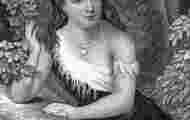It all starts in Salem with children’s games. Two very young girls, Elizabeth “Betty” Parris and Abigail Williams, cousins of about ten years respectively daughter and niece of a pastor, decided in the fall of 1691 to try their hand at divination: they wanted to know who they would marry more later, and what will be the profession of their future husband. The game goes wrong: one of the girls thinks she sees a coffin, the two panic. A few months later, in the winter of 1692, they were seized with convulsions. The village doctor, a certain William Griggs, was called to their bedside. Had he concluded that there was a medical disorder (the hypothesis of epilepsy or possible ergot poisoning was mentioned long after), the story could have ended there: but Dr Griggs diagnoses possession.
Panic in the village, the little girls are urged to name who would have cast a spell on them. They then accuse the slave of Pastor Parris, a young woman from Barbados called Tituba. “Unsurprisingly, the first accused is a woman from the bottom of the social ladder, notes the historian Bertrand Van Ruymbeke, author of a History of the United States from 1492 to the present day (Tallandier, 2021). And quickly, she admits.“She actually recounts harmless rituals, including baking a magic cake to identify who meant Betty Parris harm. White witchcraft, but witchcraft all the same, in the eyes of the Puritans: Tituba is imprisoned.
Salem: a series of extraordinary trials
But the accusations continue. The two cousins give other names, the inhabitants of the village follow in their footsteps, and it is an epidemic of denouncements which spreads over Salem. “New England has seen a lot of witchcraft cases since the 1640s, recalls Bertrand Van Ruymbeke. But each time, a handful of people are accused, a few are imprisoned, one or two are hanged. In Salem, more than 100 people will be accused of witchcraft, and 20 of them will be executed. These trials therefore have an extraordinary dimension: the whole colony is involved.” In May, the governor of Massachusetts William Phips creates and mandates a court of justice headed by his deputy governor, William Stoughton. Seven judges from Boston are dispatched to follow her in Salem, with the mission of hearing the “possessed” and trying the accused.
Throughout the summer of 1692, the court held session once a month. For the pseudo-sorcerers, it is the slaughter: no acquittal is pronounced, all the trials end in a death sentence. Those who plead guilty and designate other “sorcerers” escape capital punishment, the others are hanged. Only one man, Giles Corey, an old farmer who, out of pride or senility, refuses to speak in court, is sanctioned with a particularly atrocious punishment, “the strong and hard punishment”. He is pinned to the ground and crushed by heavy stones until death ensues: his ordeal lasts three days.
Six men and 14 women were thus executed for witchcraft during the summer of 1692. It was the intervention of a pastor and theologian from Boston, the very influential Increase Mather, who put an end to the macabre series. On October 3, he published an essay entitled Cases of Conscience Concerning Evil Spirits (Cases of conscience concerning evil spirits), who pleads for the end of the trials. “It would be betterhe writes, to let 10 witches escape, rather than one innocent person being condemned.” William Phips finally agrees to put an end to the procedure, and the surviving defendants are gradually released.
⋙ Scottish government officially apologizes for women killed for witchcraft
The myth of the witch
Several commonalities connect the victims of Salem. First, nearly 80% of them are women. “Most of these women live on the margins of the community, notes Bertrand Van Ruymbeke. They are generally single, widowed or unmarried. They are therefore vulnerable women, who have no man to protect them..” We find this configuration in all patriarchal societies that have practiced witch-hunting, including the Old Continent during the Inquisition. “According to statistics, 80% of witches [condamnées en Europe] were women, writes the historian Robert Muchembled, especially older women, mostly illiterate peasant women. They were not revolted against religion […]. Marginalized from society, they were at best bitter and dissatisfied with their lot.” Still today, women accused of witchcraft in northern Ghana, where one of them was lynched in 2020, are almost all infertile, single or elderly. That is to say useless, even dangerous, for societies that confine the role of women to procreation.
But the Salem trials have an originality, notes Bertrand Van Ruymbeke: over the weeks, the profile of the accused rises on the social scale. “We start with a slave and a beggar, then we start to accuse owners, notables… Over time, the denouncements go beyond the borders of Salem. The more powerful the defendants, the further away they live: the charges even end up targeting Boston.” This is also what signs the dissolution of the court, already shaken by the pamphlet of Mather: the own wife of Governor Phips is appointed. This is no longer a simple story of religion: Salem borders on rebellion.
⋙ In Malawi, witchcraft and black magic kill
Salem Village vs. Salem Town, a deadly rivalry
Because the affair intervenes in a particularly tense socio-political context. The girls’ accusations served as sparks in the gigantic powder keg that was Salem. The city was actually divided into two parts: Salem Town, the prosperous port (still called Salem), and Salem Village (now Danvers), the agricultural hinterland. “Since the late 1670s, Salem Village had been seeking self-reliance, says Bertrand Van Ruymbeke, and in particular its religious autonomy. She wanted her own church to be recognized by the Boston congregation, and no longer depend on Salem Town for pastor selection or tax payment. But Boston had refused. The members of Village therefore harbored a growing resentment towards Town. It was discovered after the fact that the accused notables were either port dwellers or hinterland dwellers considered traitors to Village or allies of Salem Town.” Thus the Reverend George Burroughs, one of the defendants, was the former pastor of Salem Village, which he had left after a violent argument: designated as a sorcerer by resentful former parishioners, he was condemned to death and hanged. .
“It is a closed, homogeneous society, and solid in this sense, summarizes the historian. But who also feels vulnerable, far from the metropolis, exposed to the Amerindian wars. If witchcraft is punishable by capital punishment, it is because it is considered by the inhabitants of Salem as a threat to this fragile balance.“In a society deeply infused with Puritanism, all disruptive factors are attributed to Evil. Betty and Abigail have probably had a narrow escape: to try divination is to seek to know the designs of God, therefore a heresy. Ambition is reprehensible. The same seduction: physical attractiveness can disturb the peace of families, it is therefore criminal. “One of the accusers, a married man, had an erotic reverie with a womansays Bertrand Van Ruymbeke. He denounced her to the judges as a witch, accusing her of bewitching him. There were not only social and political resentments at play, but also a great latent sexual frustration, which fueled the mass hysteria.” For Salem’s accusers, Evil was everywhere, and Mather was wrong: it was better to hang ten innocent people than let a single witch go free.
Read also:
We would love to give thanks to the author of this article for this incredible web content
Salem trial: who were the victims?
Take a look at our social media accounts as well as other related pageshttps://nimblespirit.com/related-pages/



